|
|
|
Sort Order |
|
|
|
Items / Page
|
|
|
|
|
|
|
| Srl | Item |
| 1 |
ID:
157640
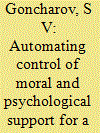

|
|
|
|
|
| Summary/Abstract |
The paper gives the author's vision of the essence and content of automating control of moral and psychological support for a formation (military unit) and suggests a model for this kind of automation at the tactical level.
|
|
|
|
|
|
|
|
|
|
|
|
|
|
|
|
| 2 |
ID:
080441
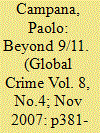

|
|
|
|
|
| Publication |
2007.
|
| Summary/Abstract |
By drawing upon the first results of an analysis carried out on the 1998-2005 period, this work tries to reconstruct the trends in terrorist attacks and their media coverage in seven international daily newspapers. Also the dynamics of media over/under-representation are investigated, as well as the existence of differentiated coverage related to the geopolitical distance/proximity of the country object of attack. Special attention is paid to an empirical analysis of the Iraqi case. The work opens with a short methodological discussion on the issue of terrorism measurement, from its operational definition to the choice of the database on which to carry out the analyses.
|
|
|
|
|
|
|
|
|
|
|
|
|
|
|
|
| 3 |
ID:
128722
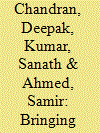

|
|
|
| 4 |
ID:
151584
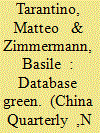

|
|
|
|
|
| Summary/Abstract |
Significant efforts towards environmental transparency have been made by the Chinese government since 2008. This paper focuses on the technical decisions shaping a database of official pollution information built and operated by a Chinese NGO known as the Institute of Public and Environmental Affairs (IPE). Issues of standardization, power distribution and institutional fragmentation are discussed. The paper illustrates a case of NGOs integrating enforcement capabilities as data centres amidst the growing reliance on processes of informational governance of environmental issues.
|
|
|
|
|
|
|
|
|
|
|
|
|
|
|
|
| 5 |
ID:
072094


|
|
|
|
|
| Publication |
Santa Monica, Rand Corporation, 1994.
|
| Description |
viii, 158p.
|
|
|
|
|
|
|
|
|
|
|
|
Copies: C:1/I:0,R:0,Q:0
Circulation
| Accession# | Call# | Current Location | Status | Policy | Location |
| 035327 | 355.03300011/KAM 035327 | Main | On Shelf | General | |
|
|
|
|
| 6 |
ID:
117020
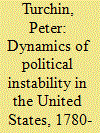

|
|
|
|
|
| Publication |
2012.
|
| Summary/Abstract |
This article describes and analyses a database on the dynamics of sociopolitical instability in the United States between 1780 and 2010. The database was constructed by digitizing data collected by previous researchers, supplemented by systematic searches of electronic media archives. It includes 1,590 political violence events such as riots, lynchings, and terrorism. Incidence of political violence fluctuated dramatically over the 230 years covered by the database, following a complex dynamical pattern. Spectral analysis detected two main oscillatory modes. The first is a very long-term - secular - cycle, taking the form of an instability wave during the second half of the 19th century, bracketed by two peaceful periods (the first quarter of the 19th century and the middle decades of the 20th century, respectively). The second is a 50-year oscillation superimposed on the secular cycle, with peaks around 1870, 1920, and 1970. The pattern of two periodicities superimposed on each other is characteristic of the dynamics of political instability in many historical societies, such as ancient Rome and medieval and early-modern England, France, and Russia. A possible explanation of this pattern, discussed in the article, is offered by the structural-demographic theory, which postulates that labor oversupply leads to falling living standards and elite overproduction, and those, in turn, cause a wave of prolonged and intense sociopolitical instability.
|
|
|
|
|
|
|
|
|
|
|
|
|
|
|
|
| 7 |
ID:
185194
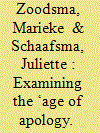

|
|
|
|
|
| Summary/Abstract |
It is often assumed that we are currently living in an ‘age of apology’, whereby countries increasingly seek to redress human rights violations by offering apologies. Although much has been written about why this may occur, the phenomenon itself has never been examined through a large-scale review of the apologies that have been offered. To fill this gap, we created a database of political apologies that have been offered for human rights violations across the world. We found 329 political apologies offered by 74 countries, and cross-nationally mapped and compared these apologies. Our data reveal that apologies have increasingly been offered since the end of the Cold War, and that this trend has accelerated in the last 20 years. They have been offered across the globe, be it that they seem to have been embraced by consolidated liberal democracies and by countries transitioning to liberal democracies in particular. Most apologies have been offered for human rights violations that were related to or took place in the context of a (civil) war, but there appears to be some selectivity as to the specific human rights violations that countries actually mention in the apologies. On average, it takes more than a generation before political apologies are offered.
|
|
|
|
|
|
|
|
|
|
|
|
|
|
|
|
| 8 |
ID:
159253
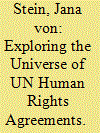

|
|
|
|
|
| Summary/Abstract |
The international human rights (HR) regime is vast and complex. Yet, most of what we know about it draws from a handful of agreements, often chosen for their prominence and/or perceived centrality to the HR project. This article argues that HR research needs to expand its scope to encompass all agreements in this realm, and presents a new data resource that enables scholars to accomplish that goal. Using the data, I demonstrate that the literature has painted an unrepresentative portrait of HR agreements. In addition to making comprehensive analysis possible, the database moves the literature forward by (1) taking into account important legal distinctions in the process of making treaties binding, (2) providing information on treaty design, and (3) considering relationships between agreements. I present several applications and discuss future areas of inquiry. Network analysis and the linking of treaty participation to HR outcomes are two notable areas of interest.
|
|
|
|
|
|
|
|
|
|
|
|
|
|
|
|
| 9 |
ID:
146930
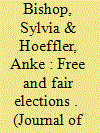

|
|
|
|
|
| Summary/Abstract |
The holding of elections has become universal but only about half of all elections are free and fair. Electoral malpractice not only distorts the quality of representation but has implications for political, social and economic outcomes. Existing datasets either provide information on election quality for a large number of elections but offer little detail, or they provide very detailed information for a small number of elections. Our data collection effort closes this gap by providing ten variables of election quality for all leadership elections for the period 1975–2011. We use these data to provide an assessment of elections that is closely tied to the commonly used term ‘free and fair’. We define ‘freeness’ of the election as the rules of the election and the process leading up to the election, and ‘fairness’ of the election refers to the events on the election day. Our data show that the quality of elections has declined over time. These electoral problems are mainly due to issues in the run-up to the elections. Using probit regressions we investigate the possible causes of election malpractice. Our analysis suggests that the freeness and the fairness of the elections are related to a number of variables, such as income, aid, executive constraints and the presence of election monitors, but that these variables have differential effects on freeness and fairness.
|
|
|
|
|
|
|
|
|
|
|
|
|
|
|
|
| 10 |
ID:
166005
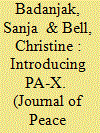

|
|
|
|
|
| Summary/Abstract |
This article introduces PA-X, a peace agreement database designed to improve understanding of negotiated pathways out of conflict. PA-X enables scholars, mediators, conflict parties and civil society actors to systematically compare how peace and transition processes formalize negotiated commitments in an attempt to move towards peace. PA-X provides an archive and comprehensive census of peace agreements using a broad definition to capture agreements at all phases of peace processes in both intrastate and interstate conflict, from 1990 to 2016. These comprise ceasefire, pre-negotiation, substantive (partial and comprehensive), and implementation agreements, disaggregated by country/entity, region, conflict type, agreement type and stage of agreement totalling over 1,500 agreements in more than 140 peace and transition processes. PA-X provides the full text of agreements, and qualitative and quantitative coding of 225 categories relating to politics, law, security, development and implementation. Data can be aggregated or merged with conflict datasets, effectively providing many datasets within one database. PA-X supports new comparative research on peace agreements, but also on peace processes – enabling tracing of how actors and issues change over time – to inform understandings of conflict termination. We illustrate PA-X applications by showing that an intricate peace process history correlates with reduced likelihood of conflict recurrence, and that cumulative provisions addressing elections see the quality of subsequent post-conflict elections improve.
|
|
|
|
|
|
|
|
|
|
|
|
|
|
|
|
| 11 |
ID:
179402
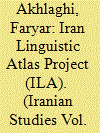

|
|
|
|
|
| Summary/Abstract |
Iran Linguistic Atlas (ILA), funded by the Research Institute for Cultural Heritage and Tourism (RICHT), is a research project for mapping the linguistic diversity of Iran. The project is aimed at recording unified and comparable data from every spoken dialect of Iran’s rural areas and producing self-organized colored maps of this diversity using a specialized software program. Its initial phase began around the mid-1970s in the form of a joint project by the then Iranian Academy of Language and the National Geography Organization. In 2001, the documented data was handed over to the Cultural Heritage Organization, to be saved and expanded. The Iran Linguistic Atlas has now been redefined as an automatic linguistic atlas with the capability of producing self-organizing colored maps according to the operator’s choices. In this article, the ILA, its background and the state of its current phase is introduced. The nature of its data, its earlier and recent field methods, its audiotapes, digital databases and computer databases of phonetic transcriptions are described. In addition, ILA software program is presented and its capability for creating automatic colored maps is discussed thoroughly.
|
|
|
|
|
|
|
|
|
|
|
|
|
|
|
|
| 12 |
ID:
175709
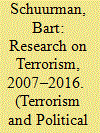

|
|
|
|
|
| Summary/Abstract |
Research on terrorism has long been criticized for its inability to overcome enduring methodological issues. These include an overreliance on secondary sources and the associated literature review methodology, a scarcity of statistical analyses, a tendency for authors to work alone rather than collaborate with colleagues, and the large number of one-time contributors to the field. However, the reviews that have brought these issues to light describe the field as it developed until 2007. This article investigates to what extent these issues have endured in the 2007–2016 period by constructing a database on all of the articles published in nine leading journals on terrorism (N = 3442). The results show that the use of primary data has increased considerably and is continuing to do so. Scholars have also begun to adapt a wider variety of data-gathering techniques, greatly diminishing the overreliance on literature reviews that was noted from the 1980s through to the early 2000s. These positive changes should not obscure enduring issues. Despite improvements, most scholars continue to work alone and most authors are one-time contributors. Overall, however, the field of terrorism studies appears to have made considerable steps towards addressing long-standing issues.
|
|
|
|
|
|
|
|
|
|
|
|
|
|
|
|
|
|
|
|
|